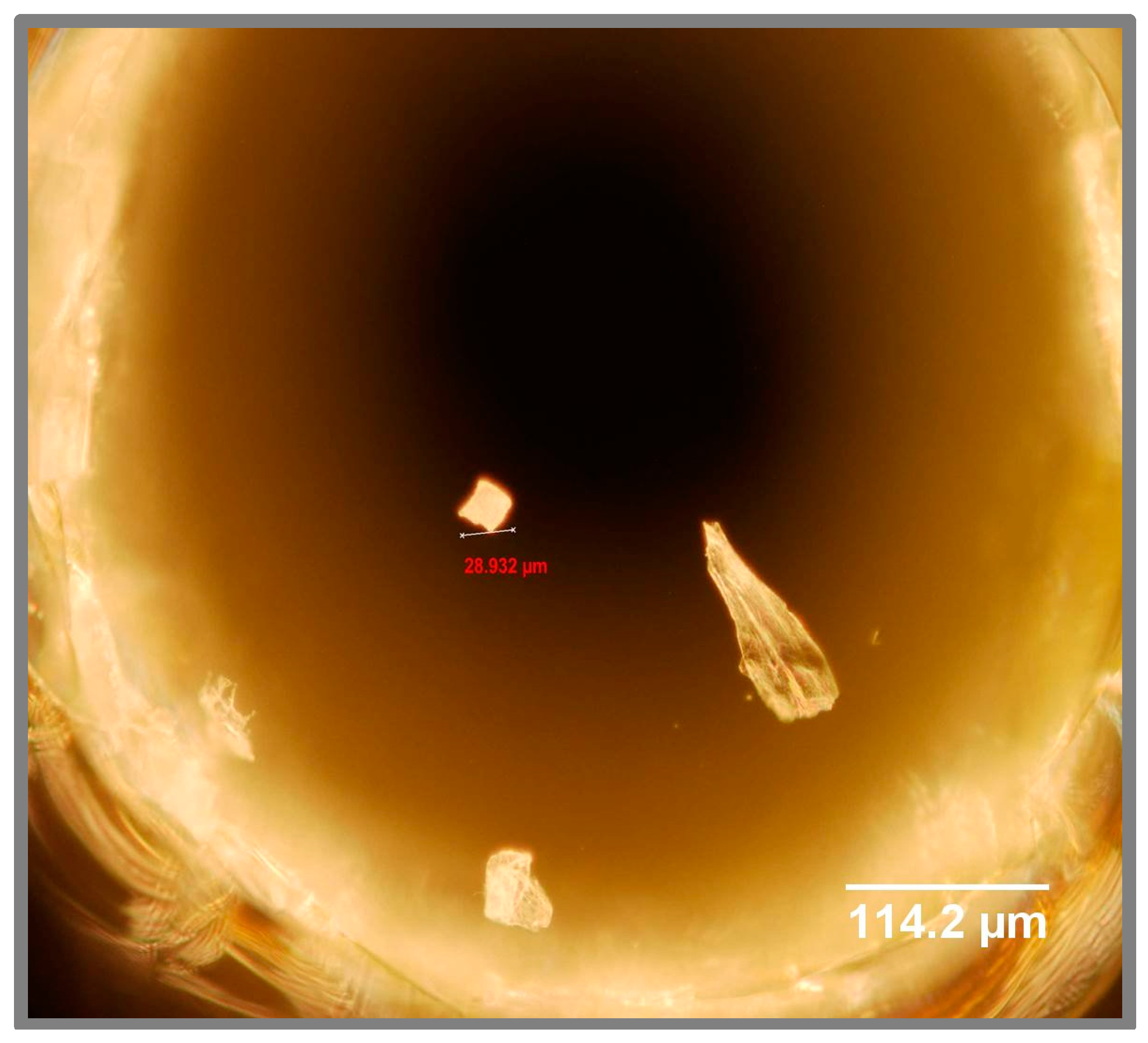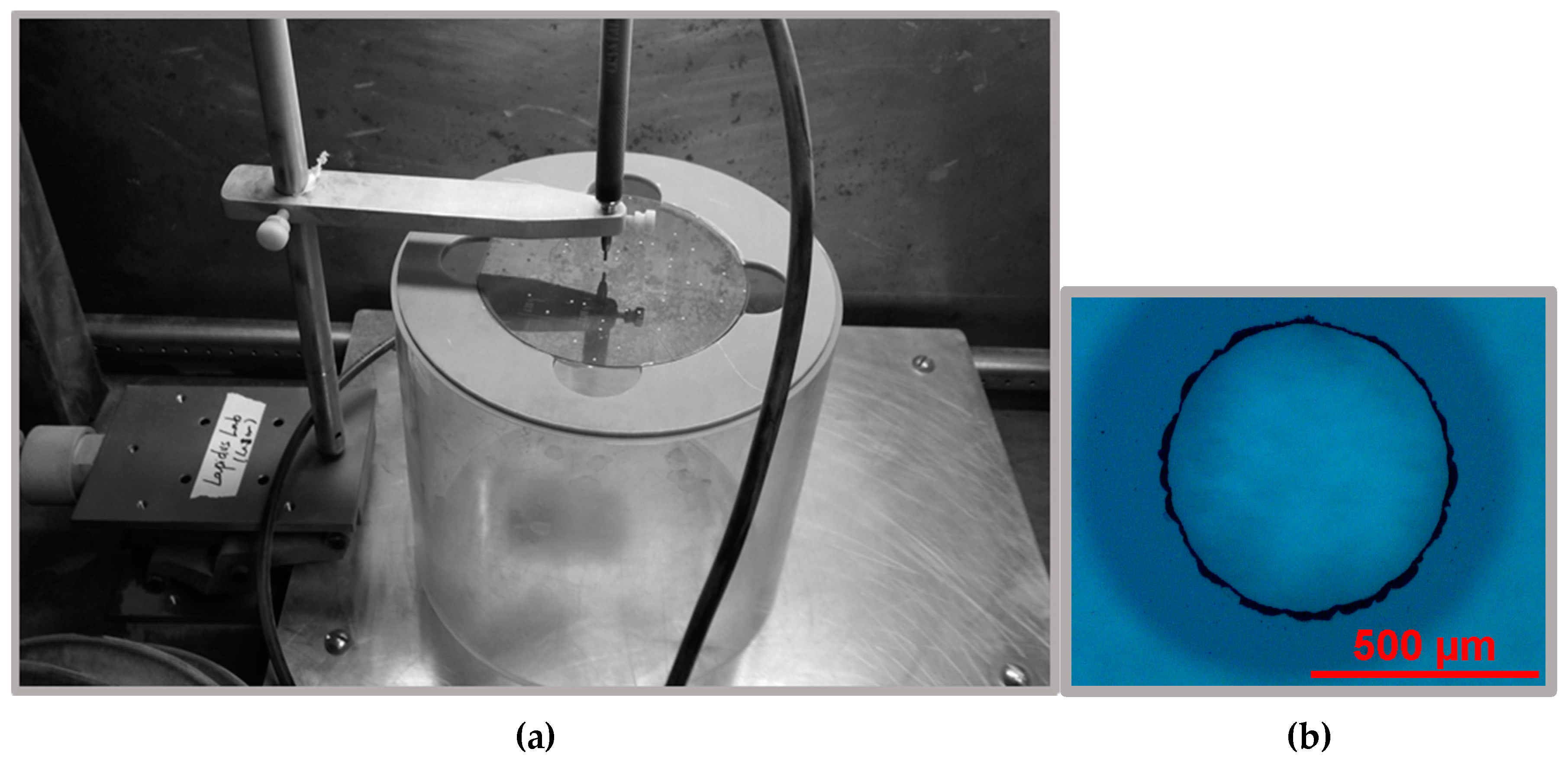Complete Procedure for Fabrication of a Fused Silica Ultrarapid Microfluidic Mixer Used in Biophysical Measurements
Abstract
:1. Introduction
2. Fabrication and Experiments
2.1. Chemicals and Materials
2.2. Process Flow
2.3. Protein Refolding Experiments
3. Results and Discussion
3.1. Microfluidic Mixers
3.2. Protein Folding
4. Conclusions
Supplementary Materials
Acknowledgments
Author Contributions
Conflicts of Interest
References
- Brody, J.P.; Yager, P.; Goldstein, R.E.; Austin, R.H. Biotechnology at low reynolds numbers. Biophys. J. 1996, 71, 3430–3441. [Google Scholar] [CrossRef]
- Knight, J.B.; Vishwanath, A.; Brody, J.P.; Austin, R.H. Hydrodynamic focusing on a silicon chip: Mixing nanoliters in microseconds. Phys. Rev. Lett. 1998, 80, 3863–3866. [Google Scholar] [CrossRef]
- Hertzog, D.E.; Michalet, X.; Jager, M.; Kong, X.X.; Santiago, J.G.; Weiss, S.; Bakajin, O. Femtomole mixer for microsecond kinetic studies of protein folding. Anal. Chem. 2004, 76, 7169–7178. [Google Scholar] [CrossRef] [PubMed]
- Hertzog, D.E.; Ivorra, B.; Mohammadi, B.; Bakajin, O.; Santiago, J.G. Optimization of a microfluidic mixer for studying protein folding kinetics. Anal. Chem. 2006, 78, 4299–4306. [Google Scholar] [CrossRef] [PubMed]
- Ivorra, B.; Hertzog, D.E.; Mohammadi, B.; Santiago, J.G. Semi-deterministic and genetic algorithms for global optimization of microfluidic protein-folding devices. Int. J. Numer. Methods Eng. 2006, 66, 319–333. [Google Scholar] [CrossRef]
- Lapidus, L.J.; Yao, S.H.; McGarrity, K.S.; Hertzog, D.E.; Tubman, E.; Bakajin, O. Protein hydrophobic collapse and early folding steps observed in a microfluidic mixer. Biophys. J. 2007, 93, 218–224. [Google Scholar] [CrossRef] [PubMed]
- Yao, S.; Bakajin, O. Improvements in mixing time and mixing uniformity in devices designed for studies of protein folding kinetics. Anal. Chem. 2007, 79, 5753–5759. [Google Scholar] [CrossRef] [PubMed]
- Waldauer, S.A.; Wu, L.; Yao, S.H.; Bakajin, O.; Lapidus, L.J. Microfluidic mixers for studying protein folding. J. Vis. Exp. 2012, 62, 3976. [Google Scholar] [CrossRef] [PubMed]
- Ivorra, B.; Redondo, J.L.; Santiago, J.G.; Ortigosa, P.M.; Ramos, A.M. Two- and three-dimensional modeling and optimization applied to the design of a fast hydrodynamic focusing microfluidic mixer for protein folding. Phys. Fluids 2013, 25. [Google Scholar] [CrossRef]
- Wu, L.; Lapidus, L.J. Combining ultrarapid mixing with photochemical oxidation to probe protein folding. Anal. Chem. 2013, 85, 4920–4924. [Google Scholar] [CrossRef] [PubMed]
- Jiang, L.G.; Zeng, Y.; Sun, Q.Q.; Sun, Y.R.; Guo, Z.H.; Qu, J.N.Y.; Yao, S.H.A. Microsecond protein folding events revealed by time-resolved fluorescence resonance energy transfer in a microfluidic mixer. Anal. Chem. 2015, 87, 5589–5595. [Google Scholar] [CrossRef] [PubMed]
- DeCamp, S.J.; Naganathan, A.N.; Waldauer, S.A.; Bakajin, O.; Lapidus, L.J. Direct observation of downhill folding of lambda-repressor in a microfluidic mixer. Biophys. J. 2009, 97, 1772–1777. [Google Scholar] [CrossRef] [PubMed]
- Zhu, L.; Ghosh, K.; King, M.; Cellmer, T.; Bakajin, O.; Lapidus, L.J. Evidence of multiple folding pathways for the villin headpiece subdomain. J. Phys. Chem. B 2011, 115, 12632–12637. [Google Scholar] [CrossRef] [PubMed]
- Waldauer, S.A.; Bakajin, O.; Lapidus, L.J. Extremely slow intramolecular diffusion in unfolded protein L. Proc. Natl. Acad. Sci. USA 2010, 107, 13713–13717. [Google Scholar] [CrossRef] [PubMed]
- Tathagata, R.; Haixin, Z.; Deirdre, R.M. Deep reactive ion etching of fused silica using a single-coated soft mask layer for bio-analytical applications. J. Micromech. Microeng. 2010, 20, 097002. [Google Scholar]
- Ahamed, M.J.; Senkal, D.; Trusov, A.A.; Shkel, A.M. Study of high aspect ratio nld plasma etching and postprocessing of fused silica and borosilicate glass. J. Microelectromech. Syst. 2015, 24, 790–800. [Google Scholar] [CrossRef]
- Waldauer, S.A. Early Events in Protein Folding Investigated through Ultrarapid Microfluidic Mixing. Ph.D. Thesis, Michigan State University, East Lansing, MI, USA, 2010. [Google Scholar]
- Jäger, M.; Nguyen, H.; Crane, J.C.; Kelly, J.W.; Gruebele, M. The folding mechanism of a β-sheet: The WW domain. J. Mol. Biol. 2001, 311, 373–393. [Google Scholar] [CrossRef] [PubMed]






© 2017 by the authors. Licensee MDPI, Basel, Switzerland. This article is an open access article distributed under the terms and conditions of the Creative Commons Attribution (CC-BY) license ( http://creativecommons.org/licenses/by/4.0/).
Share and Cite
Izadi, D.; Nguyen, T.; Lapidus, L.J. Complete Procedure for Fabrication of a Fused Silica Ultrarapid Microfluidic Mixer Used in Biophysical Measurements. Micromachines 2017, 8, 16. https://doi.org/10.3390/mi8010016
Izadi D, Nguyen T, Lapidus LJ. Complete Procedure for Fabrication of a Fused Silica Ultrarapid Microfluidic Mixer Used in Biophysical Measurements. Micromachines. 2017; 8(1):16. https://doi.org/10.3390/mi8010016
Chicago/Turabian StyleIzadi, Dena, Trieu Nguyen, and Lisa J. Lapidus. 2017. "Complete Procedure for Fabrication of a Fused Silica Ultrarapid Microfluidic Mixer Used in Biophysical Measurements" Micromachines 8, no. 1: 16. https://doi.org/10.3390/mi8010016





